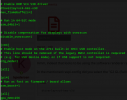Counter intuitively and unknown to many, the very latest release of Raspberry Pi OS (bullseye) does not provide 3D acceleration (OpenGL) support for the Raspberry Pi 3 or older. Neither in the 32-bit or 64-bit release. This is powered (slowly) by LLVMpipe, same as FreeBSD. You can verify this via
glxinfo on both OSes.
The reason being is that VC4 (Broadcom's driver blob) was deprecated and the replacement (V3D, similar name) only robustly supports the GPU in the Raspberry Pi 4. If you enable glamor on the Pi3, it can report VC4 but it is an unsupported config resulting in crashes and graphical issues such as:
https://github.com/RPi-Distro/chromium-browser/issues/35
So you will need to use the old Raspbian (Buster) and 32-bit only to have 3D accel in Linux. Personally, I would rather keep with the newer OS and use LLVMpipe which offers a higher OpenGL support (4.x) compared to VC4 (OpenGL 2.1).
Some more info I just found is
here.



